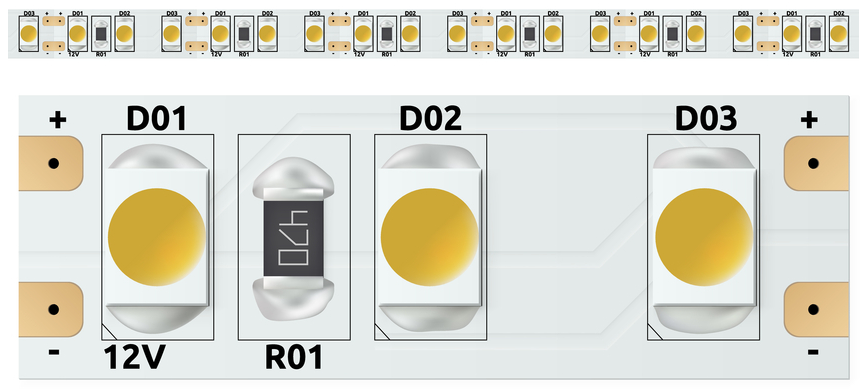LEDs are slowly becoming the norm for all sorts of lighting requirements, whether it is for living room, outdoors, kitchen, automobiles etc. You can find LED lighting in several form factors such as regular incandescent looking bulbs, LED Tubes (which look similar to fluorescent tubes and CFLs), flood lights, street lights and LED Strips. Speaking of LED strip lights, we use them for decoration, accent lighting, kitchen cabinets, car interiors etc. One common question that comes up often regarding LED Strip Lights is: Can You Cut LED Strip Lights? We will find out more about the same in this guide.
Outline
ToggleA Brief Note on LED Strip Lights
An LED Strip consists of a series of LEDs arranged in the form of a strip that we can use to fix to a surface. The structure of the strips can be rigid or flexible and depending on the intensity of the light you can have an Ultra Bright Light or a Medium-Low Intensity Light.
You can use LED Strip Lights in your car, PC, home theatre room, staircase, kitchen counter, living room and many places. The Ultra Bright LED Strip Lights allow you clearly see the subjects/objects. So, they are very useful in workshops and other task lighting.
Coming to the Medium-Low Brightness LED Strip Lights, they are preferrable for decoration, setting up an ambience, flashing lights in shopping malls and other similar lighting.
5meter (about 16feet) long LED strip lights are the most commonly available options. You can get LED strips in a single-color format or in RGB format. The RGB LED Strips usually come with a tiny infrared remote control to change the colors and also adjust the brightness.
Irrespective of the shape and structure of the LED Lighting, they all run on DC Power Supply, the 12V variants are very common (in case of LED Strips) but you can also find other voltage ratings.
Can You Cut LED Strip Lights?
Coming to the main question regarding LED Strip Lights: Can You Cut LED Strip Lights? Yes. You can cut LED Strips. All manufacturers design their LED Strips to be easily cut at predetermined places.
But why do you want to cut LED Lights in the first place? As we mentioned before, LED Strip Lights are commonly available in 5meter strips. If you are planning to use these LED Strip Lights, say, as kitchen countertop lights. Then you don’t need 5meter length of LED Strip.
So, you have to cut the LED Strip lights to perfectly fit your needs. Now, another important question. Where/How to Cut LED Strip Lights? Before answering this question, we need to understand a little bit about the anatomy of a typical LED Strip Light.
For this, let us consider a simple single color LED Strip Light as an example. You can see after every three LEDs in the strip, there is an exposed copper pad corresponding to the positive and the negative power supply.
What this means is that those three LEDs are in series with a current limiting resistor and act as an independent set with respect to the rest of the LEDs in the strip. All the LED Sets (a set consists of three LEDs and a resistor) are actually in parallel with each other. So, essentially you can cut after every LED Set.
NOTE: This description of three LEDs in series with a current limiting resistor is just an example. Depending on the types of LEDs and other factors, this layout will change from one manufacture to other.
How to Cut LED Strip Lights?
Let us now see how you can cut an LED strip light. We will take the same example as before i.e., an LED Set of three LEDs in the strip.
Measure the Length
First, measure the correct length of the LED Strip you need. Depending on your application, you may need a foot, a meter, or any other length.
Look for Copper Pads (or a scissor’s logo)
Now comes the critical part. Most LED strips come with exposed copper pads after each LED Set (one parallel group). This is where you have to cut the LED Strip Lights. Some LED Strip Lights also have a scissor logo printed on these copper pads indicating the location to make a cut.
Cut the LED Strip Light
After finalizing the length of the LED Strip, check whether you have access to copper pads within your length requirements. If not, then we suggest you to use the next copper pad slightly outside your required length.
Now, take a pair of safety scissors and cut right in the middle of the copper pad. This is important as you will have enough copper for both the LED Strips in case you want to attach a strip in the future or solder power supply wires.
Conclusion
LED Strips are a fashionable way of lighting your cars, computers, staircases, kitchen countertops, home theatres and many other areas. They are available in single color, RGB with remote control, individually addressable LEDs and some even come with “smart” connectivity. But one question that pops up now and then with respect to LED Strips (especially if you are new to LED Strips) is that Can You Cut LED Strip Lights? We have seen that you can easily cut LED lights and we also saw the simple steps to follow while cutting them.


